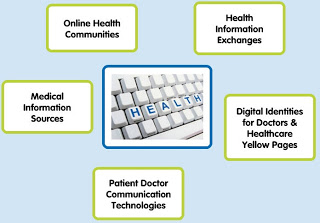The end customer in the business of Medicine needs information. Everyday technology adds new ways in which we store and share this information for many to use, reuse, improve and share some more.
In this day and age of the Internet, Mobile Phones and Social Media; Patients are empowered with the possibility of Real Time Communication, 24/7 Access to Information and Live Community Feedback.
Today’s patients have been exposed to numerous possibilities besides the ones which our forefathers would know of. This exposure has empowered this generation of patients to ask for better care, better facilities, cheaper alternatives, and more useful ways of using technology to provide healthcare as well as healthcare information. However, in spite of large amounts of information available today, a big problem that exists today is that the information is not necessarily usable when it is most needed.
To effectively facilitate Information Therapy, Information Technology must bring about a marriage of ideas with utility; IT has to ensure all actors in this ecosystem come together to improve information management for the benefit of the patient, the staff and decision-makers throughout the healthcare sector. Only then can Information Therapy be provided to various participants of the health care ecosystem through the different stages of an illness:
- Diagnosis and information gathering
- Finding a Provider
- Soliciting Second Opinion
- Accepting a diagnosis
- Participation in research
- Being an champion or advocate
For Technology to be successful at this there should be sustained focus on different avenues of Information Therapy.
We explore 5 avenues with roadmaps below:
Avenue 1: Medical Information Sources
IT vendors must work at creating Healthcare and Medical Information Knowledge Bases. This can be about medicines, diagnostics, decision trees, side effects, precautions, etc.
Technology should evolve to allow for more effective ways for Updating Information in such Knowledge Bases. These could be based on curation, criticism, collaboration to ensure that it is self adjusting, effective and patient-centered.
Advancements in Social Technology will provide new ways for spreading this information.
Innovation in Delivery mechanisms will provide easier ways for others to consume this information
This will help
— Create Informed Patients
— Create Valued Sources
— Ensure poor sources are filtered and rejected
Avenue 2: Digital Identities for Providers and Provider Information Sources
The logical first step to creating rich Databanks of Provider Information is to create identities for Providers in the electronic world. The simplest way to do this is to Create Websites for Doctors, Clinics and Hospitals. This may not necessarily be individual websites for practices which don’t want to invest in one, but even simpler informative single web pages to fulfill the purpose of creating an identity for them.
Such websites can be optimized to convey Services, Location and Contact Information, Medical Notes, Special Cases treated. Such optimization will help in disseminating useful provider information to people looking for the same. This isn’t advertising, it’s a service: people today face many choices and are hampered by lack of information, improving their ability to find information quickly is beneficial to them.
For those practices and Practioneers who decide to engage IT to create digital identities (web sites), the following guidelines must be provided:
— On your website, don’t only talk about you, tell the patients more about what diseases and disabilities you treat, what are the latest treatments, generic advice and maybe even help them going to right person if you weren’t involved.
— Use tools like interactive patient forms which can be filled before the patient arrives at the center
— Use query forms on the website so that patients can ask you about their problems and doubts; this gives the feeling to your patients that you are available to them 24/7 without actually being there
As was the case with Medical Information Sources, Advancements in Social Technology will provide new ways for sharing Provider Information.
Technology Vendors must provide easier ways for Provider information to be located and searched and which is available of different types of media.
— Create Directories of Providers based on Provider Information
— The Directories allow for Feedback on providers in a controlled environment
Avenue 3: Patient Provider Communication
True engagement comes about through two-way, mutually beneficial
conversations.
Technology must look to create multiple ways to facilitate both formal and informal Patient- Provider Communication. The telephone made a huge impact on the way we communicate, and so did email. Newer technologies must be used to offer ease of use, larger acceptance and lower costs. Many providers today communicate with their patients using skype, google chat and even facebook. Technologies must build on such success stories.
Provider –Patient Communication will also benefit if vendors Link Communication mechanisms to Provider Information Sources and Health Information Exchanges
— Provide integrations of these mechanisms with clinical and diagnostic software (EMR’s, EHR’s , etc)
— Emailing of schedules and reports to patients is a must.
— Using SMS to send Medical alerts, reminders, and schedules
— Go the extra distance and use Social Media to provide alerts and reminders to patients via Facebook Messages, Twitter DM’s, etc.
Avenue 4: Health Information Exchanges
Technology Vendors must work together to create Health Information Exchanges(HIE’s) based on interlinking of Electronic Medical Records, Electronic Health Records, Laboratory Data and Patient Health Records across Providers and Patients.
They help by providing Patients with the option to switch providers easily, allowing doctors to easily refer patients to other doctors for multiple opinions, providing direct access to laboratory data for physicians along with a number of potential benefits which are expected in the future due to the creation of a huge data bank of Medical Data including Symptoms, Diagnostics and Prescriptions.
HIE’s must be designed with Programming Interfaces and sufficient freedom to allow Technology Enthusiasts and Innovators to be able to create novel ways of using and sharing the vast volume of data within HIE’s as long as patient and provider confidentiality is not compromised.
Avenue 5: Online Health Communities
For years, patients have liked to work in groups, to support each other, to help themselves cope with illnesses which their near and dear ones don’t understand, to seek advice from others who have similar ailments. Bringing people together in collaborative dialogue to explore social conditions that are the major influences of health and illness generates deeper collective awareness and community-driven action.
Since Individuals don’t see their lives partitioned into an online and offline world, Online communities should be given as much value as offline ones. A variety of Online Communities must come up for connecting patients quickly and privately with others who share similar health experiences.
Technology today exists not only in the form of created online communities but also online community frameworks which allow just about anyone with an idea of a community to set up an online one, full with video and audio chats, whiteboarding, discussion forums and groups and all the other good stuff.
This allows the creation for integrated digital ecosystem which simultaneously addresses both individual and social dimensions of health.
— Allow Patients to engage with each other
— Allow Providers to engage with this medium
Case Studies showcasing IT providing effective Information Therapy using the avenues discussed above:
– A Hospital Website provides emergency response numbers which earlier would only be found in a book. Today the website acts like an instant phone book for someone looking for these numbers during an emergency. Hence the Website becomes a good medium to share information about the medical entity for someone to access on the go. Taking emergency medicine up a notch by providing real time information through e-health channels
– A Gynaecologist’s website allows a patient to calculate her schedule for check-ups and ultrasound visits and set reminders for the same. Whereas earlier, she would have to get it written down by the Doctor, and sure enough in all that stress call the Doctor each time to confirm, how all she needs to go is go on her trusted Doctor’s website and check the dates herself. E-Health, helping people plan their healthcare long term through tools that promote and help understand what they need to do
– A Cancer patient after each chemo session feels low and unhappy, and is tired of the emotional stress involved. Being a shy person, he never talks to anyone and shies away from contact. Now online, he has a new lease of life, being able to interact and get support from patients just like him. Moreover he can do this anonymously learning how to cope with the pressure and the pain. Learning simple remedies and tried tricks from people who know and feel what he is going through. The power of e-health through patient forums, support groups and medical help portals online, allowing information flow where there was none physically
– A patient in a remote village in South India suffering from acute pain in the abdomen has to make do with the local village doctor’s prescription. A year later, a telemedicine pilot allows this same patient to get a second opinion using a remote video link and also by sharing X-rays of the abdomen using this equipment. He also is able to identify what’s happening to him via the printouts he gets from the telemedicine center and realizes that he must work at improving his diet.
This is the 6th and final Article in a series of Articles on Using IT to facilitate Information Therapy by Nrip Nihalani and Aditya Patkar . These articles form the basis of the chapter “IT for IT” by the authors which they contributed to the book “Using Information Therapy to Put Patients First”











